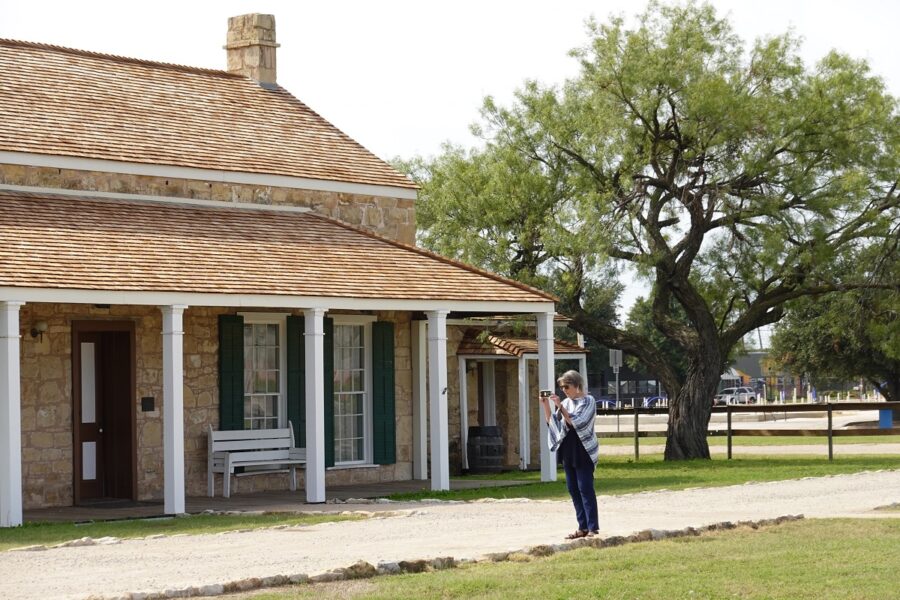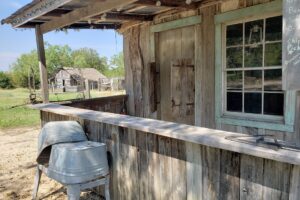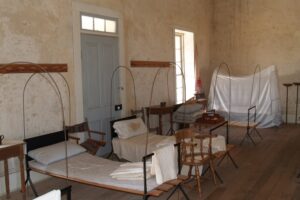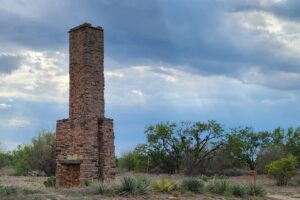Breakfast
On the way to Fort Concho, I’m not sure exactly when it happens, but somewhere along the highway between Brady and San Angelo, the land turns from soft rolling hills to flat, flat land with myriad Wind Farms. Now, as we sit in this sparkling clean Mexican restaurant — in the middle of seeming nowhere, I watch as the windmill visible out the window slowly turns its giant arms.


Based solely on Trip Advisor reviews, my original plan — foiled again — was to have breakfast at a small dive called the Morocco Café in Eden. The advice was to ignore the surroundings; the food is great. However, as with all restaurants I attempt to visit the first time, the doors are locked. The sign read CLOSED — FOR A FUNERAL. And it is a Monday, an impossible day to find a restaurant that is open in small country towns. Luckily, The Tequila Jalisco is attached to a hotel, and the sign said they were open for business.
Migas and Me
I’m hoping this will be the day that the migas I order will be the migas of my dreams, with scrambled eggs as creamy and tasty as Michael makes. Of course, they need the requisite amount of chopped peppers, diced tomatoes, melted cheese, crisp tortilla strips, and other flavorful Mexican accompaniments. I have been looking for my idea of perfection for a long time. Perhaps I am dreaming the wrong dream.


Once my breakfast is delivered and tasted — my dreams are quashed one more time. There is an abundance of small crispy tortilla rectangles, beans, and home fries. The beans are deliciously yummy, and the home fries are perfectly crisp, the tortilla strips — good. The eggs? They lose. Today’s eggs are as dry and overcooked as any migas I have ever tasted. I’m beginning to believe that this is the way migas are supposed to be prepared.
It looks like I am going to have to try creating my dream of this breakfast at home.
Fort Concho


Arriving at the large fort that an even larger city grew around, parking is a problem; so, we start our search. Michael winds his way to the back of the fort, makes a U-turn, and keeps looking. Ultimately, we land in the parking lot of the Farmer’s Market across from the Fort Concho Museum. I think we shouldn’t be here, but the market is closed today — and there is all of this space going to waste.
Museum
Compared to the forts we have visited the past several days, Fort Concho seems dressed in her Sunday best. Civilized. Almost citified. I don’t feel I am deep in the Texas Frontier at all. The museum room I am in is rustic elegance — I didn’t know there was such a thing. The old stone walls are white and bright. The modern, unobtrusive display cases melt away, and I am reminded of European infantry when examining the dress uniforms surrounding me. Michael tells me armies all over the world try to look alike. A painting of a French army during the same period proves he is right — again. Hmmm. The one difference is the helmets for the US Calvary; they have lovely long plumes of horsehair sprouting from the brass spike on top. However, the infantry helmet has nothing but the lone spike pointing skyward.




History
The most unusual thing about Fort Concho to me is that once their doors were opened, the fort remained so until the day the last soldiers stationed here lowered the US flag for the final time and marched slowly away. There was no revolving door — perhaps it was the location.
Established in 1867 along the banks of the Concho River, the mission of the inhabitants of this fort was protecting frontier settlers, stagecoaches, wagon trains, and the US Mail. During its 22-year existence as an active Army post, Fort Concho quelled hostile threats from Native American Comanches and other tribes in the area.
Again, I am surprised by history when I discover that the Comanches were not the only tribe of native Americans to inhabit this land of flat plains where one can see forever. In the 1500s, Spanish explorers recorded interaction with the Jumano people who were driven out by the Apaches in the 1690s, who were, in turn, expelled by the Comanche in the 1800s. Then came the settlers and the US Cavalry. I have to wonder — what future invader lurks in the centuries beyond today?

The Soldiers
At full strength, Fort Concho supported 400-500 men consisting of infantry and troops of cavalry, staff officers, and support personnel. The fort served as regimental headquarters for some of the most famous frontier units in the Cavalry. Notable military commanders such as William’ Pecos Bill’ Shafter commanded here.
Several regiments of Buffalo Soldiers (African American soldiers who mainly served on the Western frontier following the American Civil War) were stationed at the post during its active period. According to popular lore, the appellation of Buffalo Soldier was given to these men by Native Americans because the soldiers’ dark curly hair resembled a buffalo mane. Some say the soldiers fought so bravely and fiercely that the Indians revered them as they did the mighty buffalo.

A Soldier’s Life
A soldier’s life within the fort was regulated by the bugle. It started with reveille at 5 or 6 am and lasted until an evening dress parade and lights out at 9:30 pm. In the interim, men clad in blue woolen uniforms performed fatigue duties. (And I always thought that was the name of the work uniform when Michael served in the Army—they were impossible to iron and had to be stiffly starched.) The dictionary defines fatigue as extreme tiredness resulting from mental or physical exertion or illness. Now I wonder which came first, the chicken or the egg.
Back to 1867. The bugle sounded often — nearly every hour — not only announcing breakfast, lunch, and dinner but also a change in work assignments. Soldiers cared for the horses, policed the camp, helped in the kitchen and gardening, and most likely had to help build and maintain the buildings.
A Decline in Need
From 1881 to 1889, Fort Concho slowly declined in both need and maintenance. The Texas Rangers fought and defeated what remained of a Comanche band in the final battle of the American Indian Wars fought in Texas. Foot soldiers replaced the Cavalry Unit at Fort Concho. A little over a week before the Infantry unit arrived, the Concho River flooded, badly damaging San Angelo. As a result, the soldiers spent their first-week on-site rendering humanitarian aid.
San Angelo began to prosper, and Fort Concho began its ultimate decline for many reasons. There was no war left to fight. Due to poor maintenance, the buildings began to go to rack and ruin. fort concho became a waypoint for troops transferring elsewhere in Texas, and there was a proliferation of ranches enclosing the surrounding plains with barbed-wire fencing — soldiers were reduced to patrolling roads.


On June 20, 1889, the soldiers at Fort Concho lowered the flag for the last time. Old Glory had flown in excess of two decades over a military installation covering more than 1600 acres.
The majority of the structures at Fort Concho were built using native limestone and consisted of at least forty buildings. The limestone was a solid foundation that allowed the buildings to weather time. After the fort was abandoned, and for the next twenty years, Fort Concho was divided into residences and businesses. This small detail may explain the historic site’s pristine look and feel. Other buildings were repurposed or recycled for their materials.



Efforts to preserve and restore Fort Concho began in the 1900s and resulted in the foundation of the Fort Concho Museum in 1929. The old frontier army post is now a historic preservation project and museum, owned and operated by the City of San Angelo, Texas.
The Fort Today
Stepping outside to the expansive grounds, it feels like the fort designer said, we have the room — let’s use it! Spread things out a bit. The Fort Concho Historic District covers a portion of the fort’s original grounds and twenty-three out of the more than forty buildings. Some of the structures are the oldest in San Angelo.


Enlisted Men’s Quarters / Officer’s Quarters
The parade ground separates the officer’s quarters from those of the enlisted men. There is a vast difference in the space within these structures and the duties performed. First of all, I don’t see how the enlisted men were able to sleep on the cots provided; they must have been exhausted all of the time. And based on the stories Michael tells me and all of the storyboards I have been reading, I think they were — exhausted!



Officer’s Quarters


Enlisted men’s Sleeping Quarters and Mess Hall
The Army Courtroom
Finding our way to Administration Row, we enter a sparsely furnished room. It feels stark and cold, despite two flags and a pot-bellied stove. The first words out of my mouth are, “So this is where soldiers get court marshaled.”

Michael puts me straight and lets me know this room is for more than that — at least during his tour with the US Army so many years ago. It was also a room used for promotion board hearings and other things. Apparently, those weren’t fun either.
Weapons of War
A Caisson
After my lesson in Army procedures, we walk outside, running into maintenance workers, keeping today’s Fort Concho in pristine condition. A little further on, we step into a room containing military weapons of the Fort’s era. When I see a cannon facing backward, my historical-minded husband explains what I am looking at. It is a six-horse caisson used to transport artillery onto the battlefield. It is also loaded down with pretend ammunition — I hope. I feel like a light has dawned as I recall the words of a song.
Over hill, over dale
As we hit the dusty trail,
And the Caissons go rolling along.
In and out, hear them shout,
Counter march and right about,
And the Caissons go rolling along.
I never really knew exactly what a caisson was until today.


The Gatling Gun
My attention is drawn to a strange-looking weapon in the corner of the room. Michael tells me it is a Gatling gun. Resting on a mount between two large wheels, it has a hand crank and two barrels sticking out at the top. Upon closer inspection, I see more barrels at the bottom and on the sides.
Invented in 1861 by Richard Gatling — an inventor turned physician turned inventor — when he noticed that a majority of the soldiers fighting during the Civil War were lost to disease rather than gunshots. Gatling later wrote an explanation of his deadly invention.
“It occurred to me that if I could invent a machine gun which could by its rapidity of fire, enable one man to do as much battle duty as a hundred, that it would, to a large extent supersede the necessity of large armies, and consequently, exposure to battle and disease would be greatly diminished.”
Paul Wahl and Don Toppel, The Gatling Gun Arco Publishing, 1971
Altruistic motives created the forerunner of a killing machine still in use during the 21st Century. I wonder how Gatling would feel about it today.
Finally, it is time to say goodbye to Fort Concho. We point our toes toward San Angelo State Park for a very brief look and then toward Brady and dinner.
Fort Concho Information
Location: 630 S. Oakes Street, San Angelo, Texas 76903
Phone: 325-657-4444
Hours: Monday – Saturday: 9 am to 5 pm, Sunday: 1 pm to 5 pm
Price: Adult: $3.00, Military: $2.00, Senior (60 & above): $2.00, Students (7-17): $1.50, Children (6 & Under): free









Leave a Reply
Your email is safe with us.